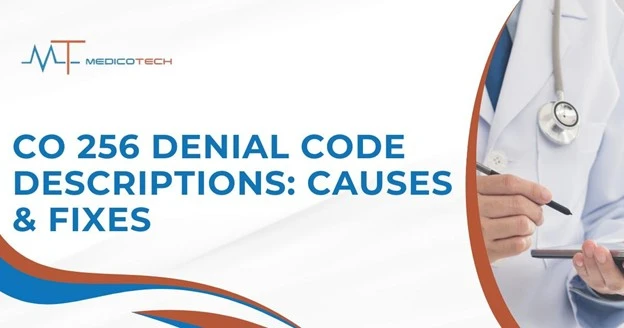What is PR 96 Denial Code?
One of the most frequent problems in the medical billing procedure is the PR 96 Denial Code. When a claim is denied because the charges are not covered, this code is assigned. In essence, it means that the patient’s insurance policy does not cover the service or procedure that was invoiced to the insurance company. This may be the result of a number of factors, including policy exclusions, services that were not considered medically required, or ineligibility at the time of care.
Healthcare providers must comprehend the PR 96 Denial Code Description in order to successfully handle billing issues. When this number is used, the healthcare provider is usually notified that they must either modify the claim or look for other payment options, including paying the patient directly, as they cannot anticipate payment from the insurance company for the particular treatment provided.
Common Reasons for PR 96 Denial
Understanding the PR 96 Denial Code Reason is crucial to preventing such denials in the future. Here are the most common causes for receiving a PR 96 Denial Code:
- Policy Exclusions:
Many insurance plans have specific exclusions. For instance, certain services like cosmetic procedures, routine exams, or non medically necessary services may not be covered. A PR 96 Denial Code may occur if the service provided falls under one of these exclusions.
- Lack of Medical Necessity:
Insurance companies often require services to be deemed “medically necessary” in order to qualify for coverage. If a provider performs a procedure or service that the insurer considers unnecessary for the patient’s condition, a PR 96 Denial Code may be applied.
- Eligibility Issues:
In some cases, a patient’s insurance may have lapsed or been inactive at the time of service. If the patient is not covered, the provider will receive a PR 96 Denial Code. This can also happen if there is an error in the patient’s insurance details or if the patient is not eligible for the service they received.
- Missing or Incorrect Prior Authorization:
Some services, especially high cost treatments or specialty care, require prior authorization from the insurance provider. If this step is overlooked, a PR 96 Denial Code may be issued, stating that the service is non covered because pre-authorization was not obtained.
- CO 234 Denial Code: In certain instances, a CO 234 Denial Code may be issued when there are specific insurance protocol issues that result in claim denial, affecting reimbursement for services rendered.
How PR 96 Denial Code Affects Your Revenue Cycle
Receiving a PR 96 Denial Code can have significant implications for your practice’s revenue cycle. When claims are denied due to non-covered charges, providers may experience:
- Delays in Payments:
Non covered services cannot be reimbursed by insurance companies, which means practices may have to wait longer to receive payment for the services provided. This disrupts the practice’s cash flow, making it more difficult to maintain operations.
- Increased Administrative Costs:
Resolving PR 96 Denials often requires administrative time and resources. Providers may need to spend extra time researching the cause of the denial, contacting insurance companies, or filing appeals. This increases operational costs, particularly for smaller practices with limited administrative support. - Impact on Financial Health:
If PR 96 Denial Codes are frequent, they can lead to a significant reduction in revenue. Practices must spend resources either on collecting from patients or attempting to get payment from secondary insurers. This can negatively affect the overall financial health of the practice.
Understanding how PR 96 Denial Code affects your revenue cycle is essential for creating strategies to reduce denials and streamline your Medical billing processes.
Can We Bill a Patient for PR 96?
In some cases, when a PR 96 Denial Code is issued, healthcare providers may wonder if they can bill the patient for the non covered service. The answer depends on the specific circumstances:
- Non-Covered Services: If the service is not covered by insurance, the PR 96 Denial Code indicates that the patient is responsible for the payment. In this case, the provider can bill the patient directly.
- Transparent Communication: It’s essential to inform the patient beforehand about the potential for non-covered services and their financial responsibility. Discussing these details upfront can prevent patient dissatisfaction and confusion later.
- Financial Assistance: If the patient is unable to pay, providers can explore options such as payment plans or financial assistance programs to ease the burden.
Understanding PR 96 Denial Code in Detail
The PR 96 Denial Code Description helps providers understand why certain claims are denied. This code specifically signals that the patient’s insurance provider has determined the service to be non-covered. Several factors contribute to this decision:
- Policy Exclusions: Some treatments or services may be explicitly excluded in the patient’s policy. These can include experimental treatments, services rendered outside of the insurance network, or services deemed unnecessary by the insurer.
- Eligibility and Coverage Issues: Insurance plans are typically valid only when patients meet specific eligibility criteria. If the patient’s coverage is inactive at the time of service, or if there are discrepancies in the patient’s details, this can trigger a PR 96 Denial Code.
- Prior Authorization: Certain services require approval before being rendered. Missing prior authorization can also lead to a PR 96 Denial Code.
By thoroughly understanding these details, healthcare providers can avoid common mistakes that lead to this type of denial and ensure that all services rendered are covered by the patient’s insurance.
How to Resolve PR 96 Denials Effectively
When a PR 96 Denial Code is issued, it’s essential to take swift action to resolve the issue. Here’s a step-by-step guide on how to address PR 96 Denials:
- Review the Remittance Advice (RA) or Explanation of Benefits (EOB):
Start by carefully reviewing the denial details in the RA or EOB. These documents typically explain why the claim was denied and offer additional information that can guide the resolution process.
- Verify Patient Eligibility:
Double-check the patient’s insurance coverage and eligibility status. If there is an issue with the patient’s insurance, such as inactive coverage or incorrect details, contact the insurance provider to clarify the situation and correct any errors.
- Check for Prior Authorization:
If the service required prior authorization but was not obtained, investigate if retroactive authorization is possible. If not, you may need to appeal the denial with supporting documentation.
- Appeal the Denial:
If you believe the denial is incorrect, initiate the appeal process with the insurance provider. Make sure to include all relevant documentation to support your claim, and ensure that you follow the payer’s specific guidelines and deadlines for submitting appeals.
By following these steps, you can significantly increase the chances of having the PR 96 Denial Code overturned and securing the reimbursement you’re owed.
PR 96 Denial Appeal Process
When a PR 96 Denial Code is issued, and you believe it is unwarranted, appealing the decision is an essential step in recovering payment for the service rendered. The appeal process may seem complex, but following a structured approach increases the likelihood of a successful outcome. Here’s how to appeal a PR 96 Denial Code:
Step-by-Step Appeal Process:
- Review Denial Details:
Start by carefully reviewing the Remittance Advice (RA) or Explanation of Benefits (EOB). These documents will provide a clear explanation of why the claim was denied and often contain specific instructions for submitting an appeal.
- Gather Required Documentation:
Prepare all the necessary documentation that supports the medical necessity of the service. This could include:
- Medical records
- Physician notes
- Test results or lab reports
- Letters of medical necessity
- Verify Insurer’s Appeal Process:
Every insurance company has its own appeal process. Review the insurer’s appeal guidelines, which are often outlined in the EOB or RA. These guidelines typically specify what documentation is required, the appeal deadlines, and the preferred method of submission (e.g., online, by mail).
- Prepare a Comprehensive Appeal Letter:
Write a clear and concise appeal letter outlining the reasons for disputing the PR 96 Denial Code. Make sure to include:
- Patient details (name, ID number, date of service)
- A reference to the denial code (PR 96)
An explanation of why the service should be covered based on medical necessity or policy exceptions
- Any supporting documentation that strengthens your case
- Submit the Appeal:
Submit your appeal within the timeframe specified by the insurance company. Ensure that you include all the required documents and that everything is properly organized.
- Follow Up:
After submitting the appeal, follow up with the insurance company to confirm receipt and track the status of your appeal. Keep a record of all communications.
Successfully appealing a PR 96 Denial Code requires persistence and careful attention to detail. By following the proper steps, you can improve your chances of overturning the denial.
Preventing PR 96 Denials: Best Practices
Preventing PR 96 Denials is critical for maintaining a healthy revenue cycle. By proactively addressing the common causes of these denials, you can minimize the chances of facing payment delays or denials altogether. Here are best practices to help avoid PR 96 Denials:
Key Preventive Measures:
- Accurate Insurance Verification:
Always verify a patient’s insurance coverage before services are rendered. This step ensures that you know exactly what is covered under the patient’s plan and whether the procedure is eligible for reimbursement. Accurate verification also helps identify policy exclusions and potential eligibility issues early.
- Ensure Prior Authorization is Obtained:
For services that require prior authorization, make sure that the approval is obtained well in advance. Services that require pre-approval, such as elective surgeries, durable medical equipment (DME), or high-cost treatments, can be denied if this step is missed.
- Detailed and Accurate Coding:
Ensure that your billing team uses the correct CPT/HCPCS codes and includes the appropriate modifiers. Incorrect coding or missing modifiers can result in PR 96 Denials. Regularly update your coding practices to align with the latest changes in insurance policies and billing standards.
- Detailed Documentation:
Provide thorough documentation to justify the medical necessity of the service. Insurance companies are more likely to approve claims if there is clear documentation showing that the service was necessary for the patient’s condition.
- Regular Training for Staff:
Make sure your billing and coding staff is consistently trained on the latest insurance requirements and prior authorization protocols. Staying updated on payer policies and changes in regulations is key to avoiding errors that lead to denials.
By implementing these practices, you can greatly reduce the occurrence of PR 96 Denials and ensure that your claims are processed smoothly.
9. How to Handle PR 96 Denials from BCBS (Blue Cross Blue Shield)
Dealing with PR 96 Denials from Blue Cross Blue Shield (BCBS) requires understanding how BCBS processes claims and the common reasons they issue denials. Here’s a step-by-step guide to handling BCBS PR 96 Denials:
Steps for Handling BCBS PR 96 Denials:
- Understand BCBS Policies:
Different BCBS plans have different rules for coverage. Familiarize yourself with BCBS Local Coverage Determinations (LCDs) for your region. This will give you insights into what is covered, what is excluded, and the documentation needed for approval.
- Verify Patient Eligibility:
Double-check that the patient’s BCBS plan is active and that the service provided is within the plan’s network. BCBS PR 96 Denials can result from eligibility issues or out-of-network services.
- Obtain Prior Authorization if Required:
Some services, especially high cost procedures or treatments, may require prior authorization. If BCBS denies the claim due to lack of prior approval, work with the insurance company to obtain retroactive authorization (if allowed) or file an appeal.
- Review BCBS Denial Codes and Remark Codes:
Carefully review the EOB or RA for BCBS-specific denial codes or remark codes that may provide additional context. These codes will guide you on why the claim was denied and how to correct it.
- File an Appeal if Necessary:
If you believe the PR 96 Denial Code was incorrectly applied, follow BCBS’s appeal process. Ensure that you submit all required documentation and clearly explain why the service should be covered under the patient’s plan.
Verifying Insurance Coverage to Avoid PR 96 Denial
One of the most effective ways to avoid PR 96 Denials is through thorough insurance coverage verification. This process helps confirm that the patient’s insurance is active, eligible, and covers the services provided. Here’s how to effectively verify insurance coverage:
Steps for Verifying Insurance Coverage:
- Verify Patient Eligibility Before Service:
Ensure that you contact the insurance company before any services are rendered to verify the patient’s insurance status. Confirm that the insurance is active, that the patient is eligible for the services, and that the service is covered under their plan.
- Check for Policy Exclusions:
Review the patient’s plan details to identify policy exclusions. Some services, such as cosmetic procedures or experimental treatments, may not be covered. Verifying this upfront helps you avoid performing services that won’t be reimbursed.
- Confirm Network Restrictions:
Many insurance plans, including BCBS, have restrictions on which providers and facilities are covered. Ensure that you are within the insurance network and that the patient is eligible to receive treatment at your facility.
- Use Insurance Verification Tools:
Many insurance companies provide online tools to verify eligibility and coverage. Utilize these tools to streamline the verification process and reduce errors.
By performing thorough insurance verification, you can avoid costly PR 96 Denials and prevent disruptions to your revenue cycle.
The Role of Prior Authorization in Preventing PR 96 Denials
Prior authorization is a critical step in preventing PR 96 Denials, especially for services or treatments that require approval from the insurance provider before they can be rendered. Failure to obtain prior authorization can result in claims being denied as non-covered charges. Here’s why prior authorization matters:
How Prior Authorization Prevents PR 96 Denials:
- Required for High-Cost or High-Risk Services:
Insurance companies often require prior authorization for expensive treatments or surgeries. If this approval is not obtained, the insurer may deny the claim with a PR 96 Denial Code.
- Ensures Medical Necessity:
Prior authorization helps confirm that the service is medically necessary. Insurance companies want to ensure that the treatments being provided align with the patient’s condition and the insurance plan’s guidelines.
- Avoids Payment Delays:
Obtaining prior authorization prevents payment delays by ensuring that the services provided are covered before the procedure takes place. This eliminates the need for retroactive authorizations, which can be time-consuming and may still result in a denial.
By ensuring that prior authorization is obtained for applicable services, you can reduce the risk of PR 96 Denials and ensure smoother claim processing.
Communicating with Patients About PR 96 Denials and Financial Responsibility
When a PR 96 Denial Code is issued, clear and transparent communication with patients is essential to manage their expectations and minimize conflicts. Here’s how to handle these conversations:
Effective Communication Strategies:
- Explain the Reason for the Denial:
Start by explaining the reason for the PR 96 Denial Code. Ensure that the patient understands why the service wasn’t covered by their insurance plan, whether it was due to exclusions, eligibility issues, or a lack of prior authorization.
- Discuss Payment Options:
If the patient is responsible for the non-covered charges, discuss payment options such as setting up a payment plan, offering discounts, or helping them apply for financial assistance programs.
- Provide Alternative Treatment Options:
If the service is non-covered, consider offering alternative treatment options that may be covered by their insurance. Discussing these options upfront can prevent patient frustration and improve their overall experience.
- Offer Support for Appeals:
If the patient wishes to appeal the denial, offer to support them by providing necessary documentation or guidance through the appeal process.
By maintaining open communication with patients, you can ensure a smoother experience when dealing with PR 96 Denials and prevent any potential dissatisfaction or confusion.
Conclusion
In conclusion, understanding and managing PR 96 Denial Codes is essential for healthcare providers to maintain a healthy revenue cycle. By recognizing the common causes of these denials, such as policy exclusions, medical necessity issues, and eligibility problems, providers can take proactive steps like verifying insurance coverage, securing prior authorization, and ensuring accurate coding. Effectively addressing these denials through the appeal process and clear communication with patients can minimize disruptions in cash flow and reduce financial strain on practices. With these strategies in place, healthcare providers can improve their billing processes, ensure timely reimbursements, and foster better relationships with both insurance companies and patients.




